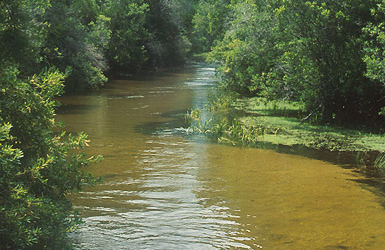Simply stated, decomposition is the breakdown of matter into its basic components. When discussed in terms of environmental processes, it includes the breakdown of dead organic plant material (leaves, stems, etc.) by micro-organisms. When plant material decomposes and sinks to the bottom of a waterbody, it leaves behind a layer of sediment or muck—a process called sedimentation.
Over time, the accumulation of sediments on the bottom causes the lake to become shallower. Eventually, it can turn into a marsh, or even a grassland or forest.
In addition to contributing organic matter to a waterbody, these materials add nutrients in the form of nitrogen and phosphorus. Excess nutrients allow more plant and algae growth. When these additional plants drop leaves and stems, or die and decompose, more sediment is added to the lake bottom.
As the lake becomes shallower, emersed plants that grow along the shoreline can grow closer to the center of the lake, creating a marsh-like waterbody. As these plants eventually die and decompose, they create more sediment buildup, and a shallower waterbody, and trees may start to grow. A swamp may now exist where there once was a lake.
These processes contribute to the natural aging or nutrient enrichment of a lake: eutrophication. Without the added nutrients from human activities (such as stormwater and agricultural runoff), or invasive aquatic plant infestations, eutrophication is a slow occurrence that contributes to a lake becoming a marsh or swamp over hundreds to thousands of years. Typical rates of sedimentation range from 1–10 millimeters per year. This translates to a rate of 3 feet per 1,000 years and more.
The growth and proliferation of invasive aquatic plants speeds up the decomposition and sedimentation processes as more plants are shedding organic material or dying. When plant managers treat the lake to control the nuisance plants, dense concentrations of plants die, decompose, and accumulate on the lake bottom. This process not only adds sediment, but decaying plants also use oxygen in the water–oxygen that native plants and animals need to survive.
When maintenance control strategies are used, small populations of nuisance plants are managed before they become large infestations. This reduces the amount of decaying plant material in the water, thus reducing sedimentation and oxygen depletion.
Even though sedimentation typically is a slow and natural process, it occurs more rapidly in some lakes. Florida lakes are typically warm and shallow, the right conditions for rapid plant growth and sedimentation. For lakes that are used for recreation, water management, or aesthetic purposes, people may choose to remove the sediment accumulation to maintain the lake for its intended functions. Read about a muck removal project on Lake Tohopekaliga.
Many factors contribute to the life cycle of a lake including temperature, climate, shape of the lake, oxygen concentrations, water chemistry, water movements, and human activities. Aquatic plant management considers all of these factors when managing waterbodies.
